
3. Office of Dreams
Opening 28th May – 13th June 2021
Here, the Department of Public Activities of the museo de la democracia is concentrated. In collaboration with artists, specialists and actors from different socio-cultural groups, a program will connect with initiatives and cultural micro-phenomena active in Latin America. The works in this chapter correspond with a self-reflexive educational program, that emphasises the community museum model, which is highly present in the region. These ›Museos Comunitarios‹ are founded on the desire to recreate, give meaning to and systematise the collective memory of local communities as a tool to strengthen their own identities, resisting historical processes of silencing and repression.
In this spirit, the museum presents works from and collaborations with artistic projects that relate to Latin American community museums. The work of Maria Thereza Alves »Son del pueblo« relates to the archaeological collection of the Museo Comunitario del Valle de Xico on the outskirts of Mexico City. Marcela Moraga collaborates with a collective of young activists to found the Museo del Agua [Museum of Water] in Renaico, southern Chile, while artist Julia Mensch cooperates with the Museo del Hambre [Museum of Hunger].
One of the main resources of the museum is the audio archive »Archivo sonoro militante – Las protestas de las calles de América Latina« produced by artist Manuela García Aldana in collaboration with the ›Oficina de Sueños‹ of the museo de la democracia. This program investigates the sound dimension of uprisings and protests, compiling anonymous donations of audio material.
Maria Thereza Alves
“Son del pueblo”, 2020
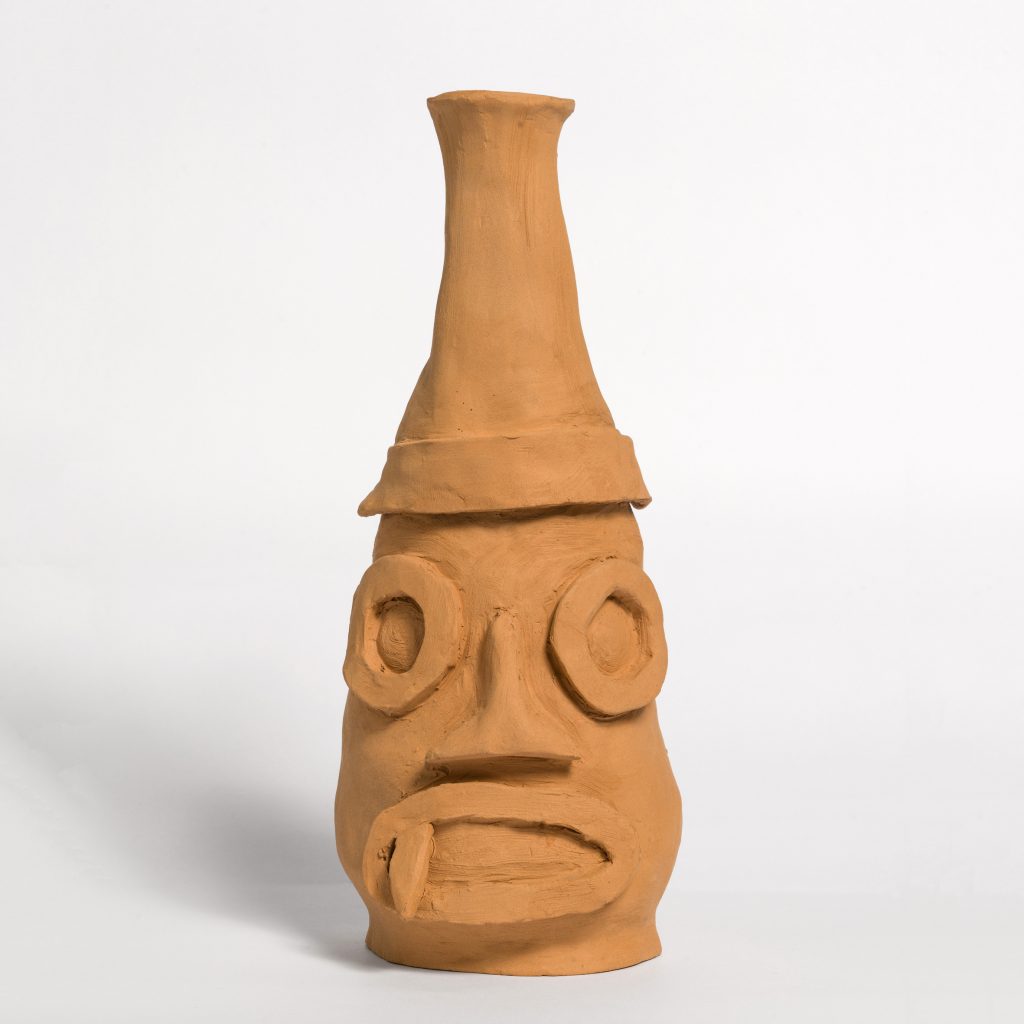
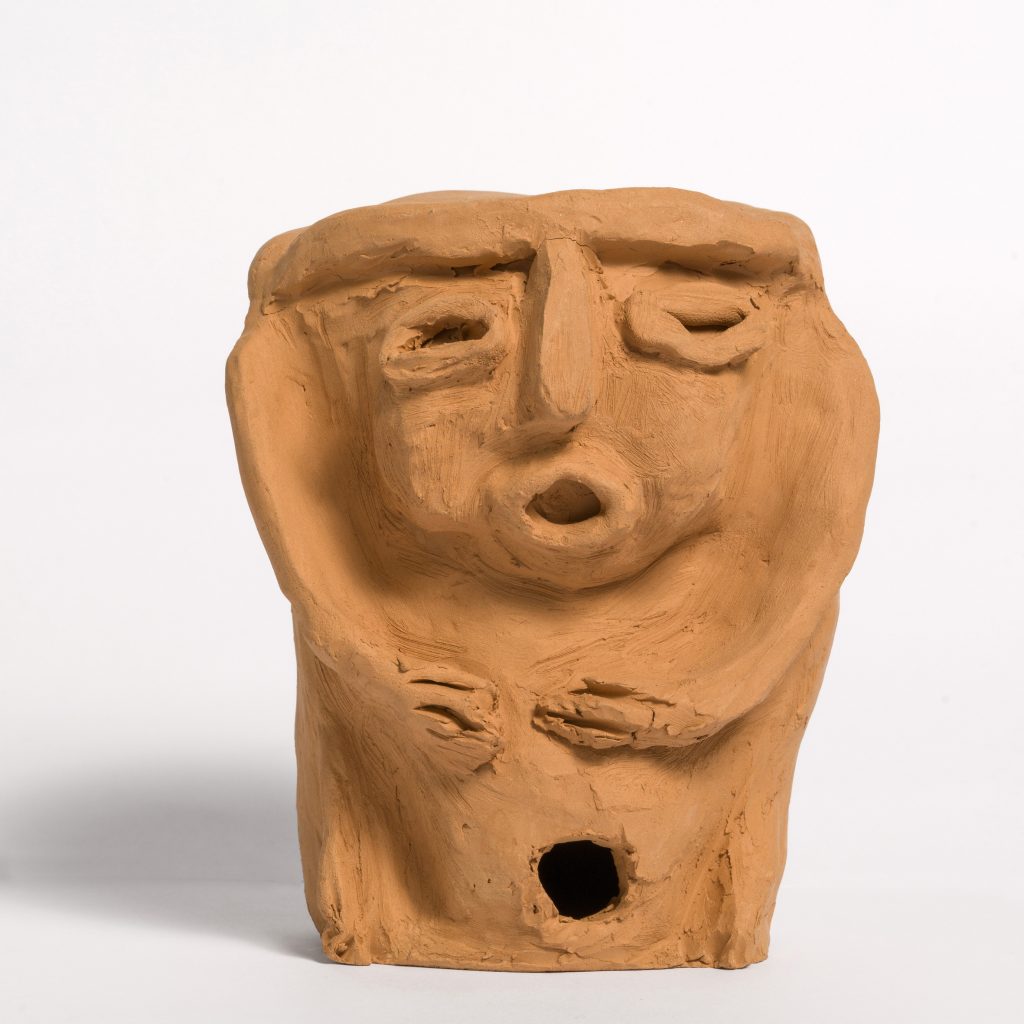
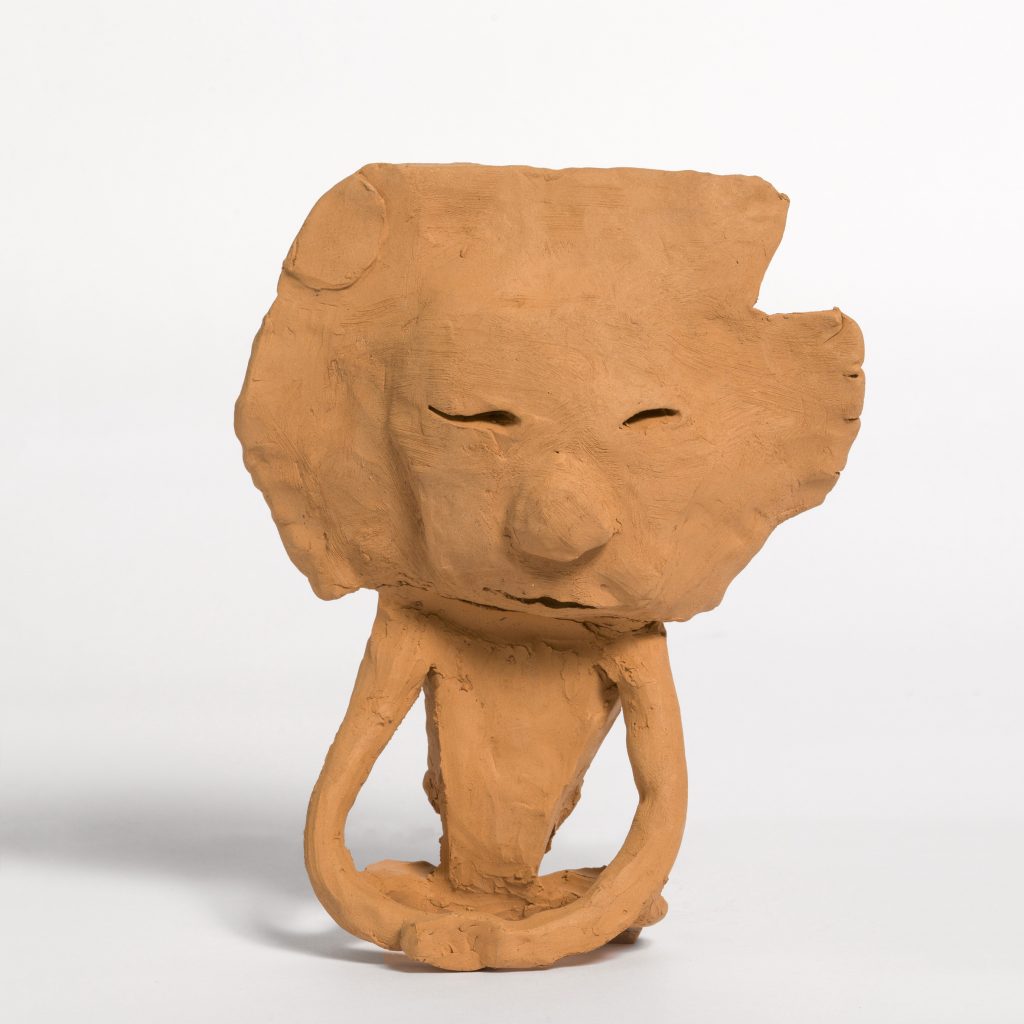
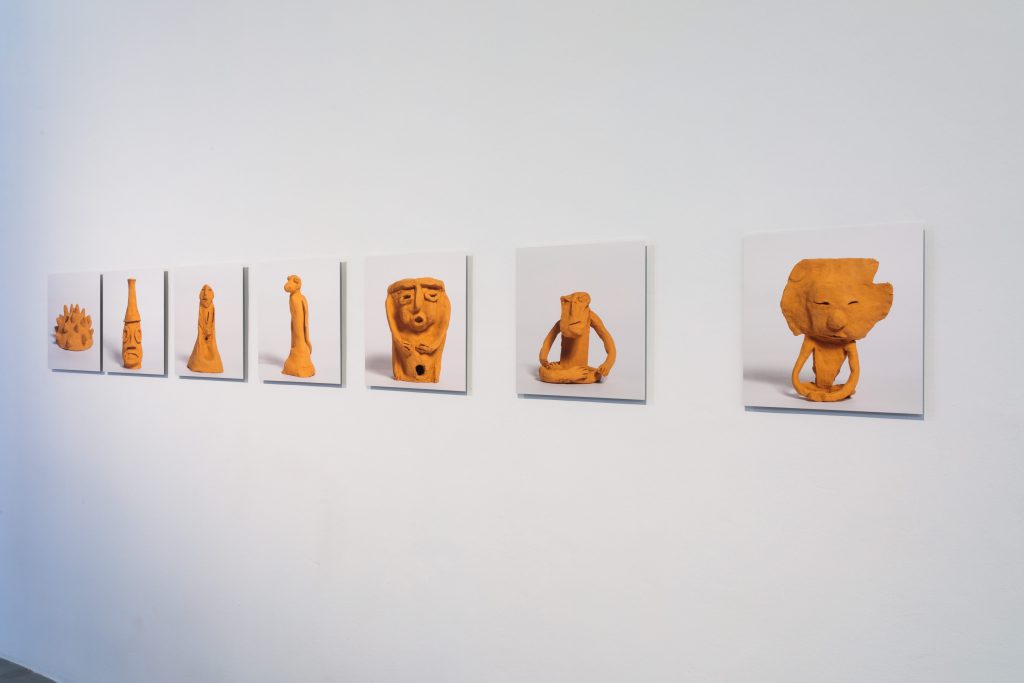
6 pictures print on Aluminium DIBOND, 60 x 60 cm, ceramic figures, different dimensions.
The photographed pieces shown here are unbaked clay replicas of archaeological pieces, as well as original pieces inspired by findings in the collection of the Museo Comunitario del Valle de Xico, a community on the outskirts of Mexico City. The museum has been in charge of recovering the cultural heritage of the area. Despite this, this grassroots institution is constantly besieged by municipal authorities who threaten to close it down – even by illegal means.
The project we present here, “Son del Pueblo” is one of the actions carried out since 2009 by Maria Thereza Alves to support the Community Museum of the Xico Valley. The action consists of a call to people located in different parts of Mexico and the world to make ceramic works based on the collection of the Community Museum. The images are posted on Instagram, on the Museum’s Facebook site, as well as on Maria Thereza Alves’ site, including the name and city of residence of each author in this process that replicates and expands the material collection as well as the life horizons of the Community Museum.
The photographed pieces are, from left to right: two figures made by Maria Thereza Alves inspired by objects from the collection. Next, the Mexica god of fire, U eueteotl, an incense-burning figure in the shape of a porcupine, simulating a smoking volcano; the Mexica god of rain, Tlaloc, as well as a pair of human figures found in the community’s self-managed excavations.
Maria Thereza Alves. São Paulo, 1961
Alves has worked and exhibited internationally since the 1980s, creating a body of work investigating the histories and circumstances of particular localities to give witness to silenced histories. Her projects are researched-based and develop out of her interactions with the physical and social environments of the places she lives, or visits for exhibitions and residencies. These projects begin in response to local needs and proceed through a process of dialogue that is often facilitated between material and environmental realities and social circumstances. While aware of Western binaries between nature and culture, art and politics, or art and daily life, she deliberately refuses to acknowledge them in her practice. She chooses instead to work with people in communities as equals through relational practices of collaboration that require constant movement across all of these boundaries.
http://www.mariatherezaalves.org
Marcela Moraga Salvemos el río Renaico
Algunos documentos del Museo comunitario del Agua, río Renaico, 2020
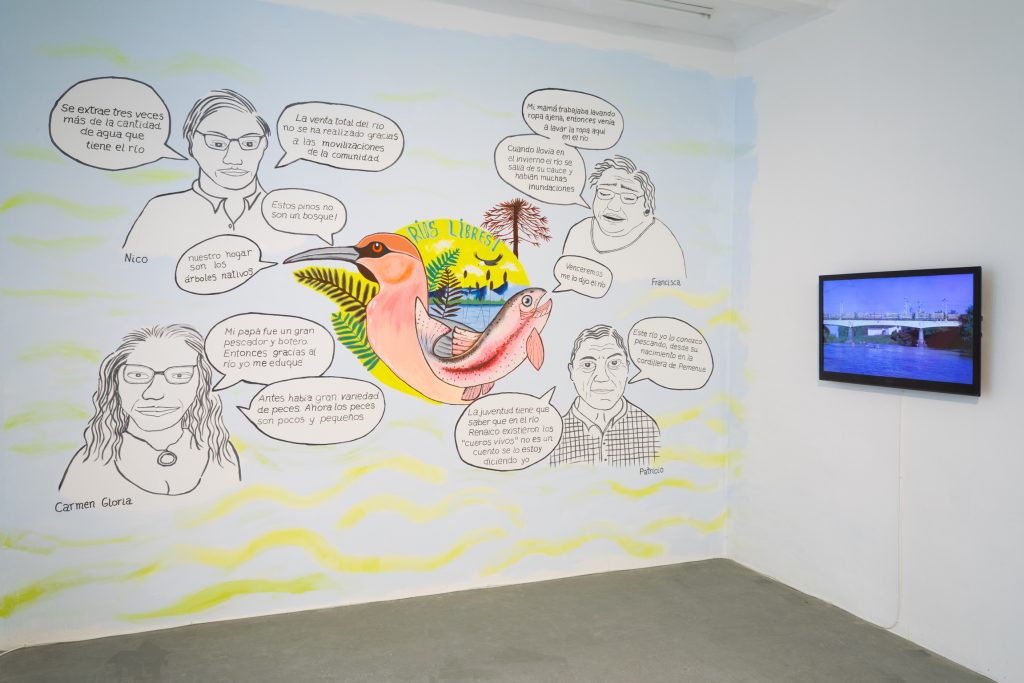

Installation consisting of a wall painting, a video and two photographs. Variable dimensions.
Video: 4 minutes. Original idea by Marcela Moraga and Salvemos el río Renaico, 2016.
Camera: Miguel Rozas. Music: “Raíces” by Weychan.
Photo of the fisherman: scan of an analogue photograph donated to the Museum’s collection.
Fine Art paper 42,0 x 29,7 cm.
Photograph of the mural by Salvemos el río Renaico. Fine Art paper 29,7 x 21,0 cm.
The artist recreates at nGbK’s space a mural painting by the collective and social organisation “Salvemos el río Renaico” from the community of Renaico, in the Araucanía region of Chile. It depicts two animals characteristic of the region: the bandurria and the trout. Moraga paints the waters of the river and portrays people with an affective bond with the river. The Renaico River once provided salmon, trout and carp, was the site of personal and collective memories, and today remains a major tourist attraction. By means of vignettes, the Chilean artist living in Berlin makes a selection of her testimonies, thus proposing a symbolic and synthetic reading of a research process with the community to form an institution that will stand the test of time: the Museo Comunitario del Agua.
The institution in the process of formation – still without a physical space – is constituted through the collection of objects and information about the river and its importance for the community. The museum has also represented the people of Renaico in lawsuits against large corporations and even the state.
A video documentary produced in 2016 with this association and collective of young environmentalists denounces the collusion between the State and large companies for the indiscriminate exploitation of the Renaico River for the benefit of the timber, paper and pulp industries, among others, and to the detriment of the water flow, which has been progressively reduced for nearly ten years. This video production is part of the Museo Comunitario del Agua’s collection, along with old photographs and children’s drawings, among other vehicles of collective and environmental memory.
Marcela Moraga San Fernando, Chile 1975
[Salvemos el río Renaico – Renaico, Chile, 2013.]
Marcela Moraga (Chile) currently lives and works in Berlin. She obtained her Bachelor of Arts from the Universidad de Chile in 1998. In 1999 she received a scholarship from the Universidad de Chile to attend the Magister in Visual Arts at the same institution. Subsequent to that she received the German DAAD scholarship to attend a Post-Graduate program in visual communication at the Hamburg University of Arts (HFBK). In 2013 she completed the Postgraduate M.A. Course “Art in Context” at the Berlin University of the Arts (UDK).
Her work has been shown internationally in galleries, museums and institutions, including: Museo de Arte Contemporáneo MAC Santiago (Chile); Kunsthalle M3 Berlin (Germany); National Center for Contemporary Art Saint Petersburg (Russia); Museu de Arte Contemporânea da Universidade de São Paulo (Brazil); TENT Centre for the Arts Rotterdam (Holland); National Museum of Contemporary Art (Republic of Korea); and the Mercosur Biennial Porto Alegre (Brazil), the Nuevos Medios Biennial Santiago (Chile) and the International Cairo Biennal (Egypt). Her work is represented by Die Ecke Arte Contemporáneo in Santiago, Chile.
http://marcelamoraga.org
Expanded research: Documentary presented during the public program
This documentary has been produced in collaboration with the activist group and it belongs to the collection of the Water Community Museum, Renaico. Original idea: Salvemos el río Renaico and Marcela Moraga. Image and editing: Miguel Rozas
Music: Rodrigo Prado – Mauricio Gutiérrez
Photography : Pablo Ocqueteau
Renaico, Chile 2016
Julia Mensch
Guaminí
Part of the ongoing project: Cartografía de un experimento a riel abierto, 2018
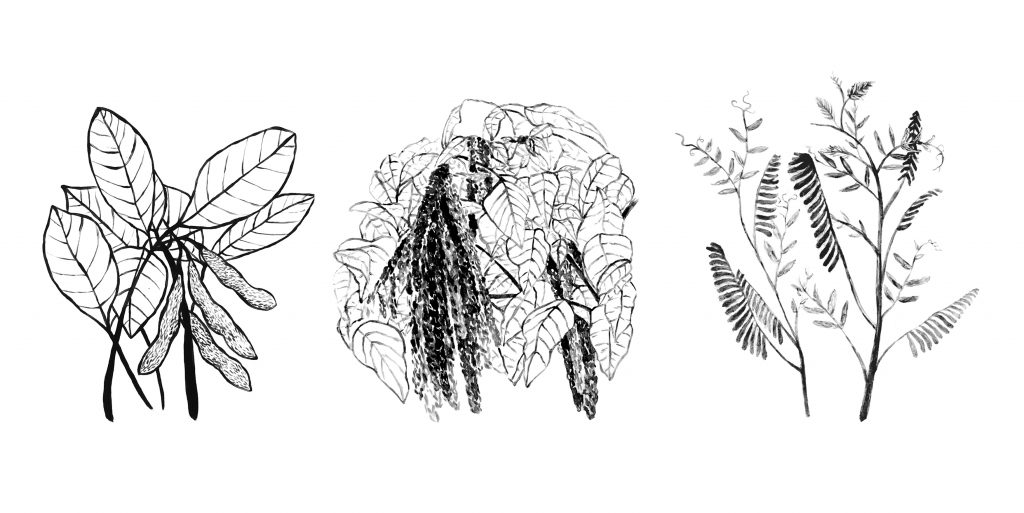
Installation with painted ceramic plates and newspaper
In collaboration with Aurelio Kopainig at Museo del Hambre in Buenos Aires, 2018.
Guaminí is a town in the province of Buenos Aires, where since 2015 a group of farmers have been working their fields agroecologically. Together with the Secretariat for the Environment and Eduardo Cerdá, an agronomist specialising in extensive and biodynamic agroecology, they have developed alternatives to the transgenic agricultural model. From this experience, they created RENAMA (Red Nacional de Municipios y Comunidades que fomentan la Agroecología – National Network of Municipalities and Communities that promote Agroecology), currently made up of 28 Argentinean municipalities. They say that they have »health, the countryside and life« in common.
Wall text: Guaminí, by Julia Mensch
The agro-industrial biotechnology boom began in Argentina in 1996, when the first genetically modified crop was approved for commercialisation: Monsanto’s (now Bayer-Monsanto) glyphosate-resistant 40-3-2 Roundup Ready soya. Since then, the GM model has been applied as if the territories were open-air laboratories. More than 350 million litres of pesticides are spilled in each campaign, the agricultural frontier is expanded year after year, and new GM crops are introduced and approved without applying or taking into account the precautionary principle. But as the negative effects on the environment and human health increase, so do resistance and alternatives: Guaminí is one of them. It is a town in the province of Buenos Aires, where since 2015 a group of farmers have chosen to work their fields agroecologically. Together with the Secretary of the Environment and Eduardo Cerdá (an agronomist specialised in extensive and biodynamic agroecology), they have developed a path that demonstrates that there are alternatives to the GM agriculture model. Based on the experience in Guaminí, they created RENAMA (National Network of Municipalities and Communities that promote Agroecology), which is currently made up of 28 municipalities from different regions of Argentina. They say that they have “health, the countryside and life” in common.
Together with Aurelio Kopainig, in March 2018 I presented the project and installation Guaminí en el Museo del Hambre. The Museum is an initiative of the Human Rights and Food Sovereignty lawyer Marcos Filardi. Created in the basement of a large house in the city of Buenos Aires with the support of many, the Museum functions as a centre for the struggle for food sovereignty. It is a place where people collectively read, observe, listen, write, cook, drink, eat and even dance. After each activity or presentation, a “healthy, safe and sovereign” dinner is shared. The food is brought by the diners, who before the dinner begins, placed around the table, tell what is the food they have brought to share and why it is “healthy, safe and sovereign”.
The Hunger Museum defines itself as a meeting and convergence centre for those who fight for food sovereignty in their territories from different spheres. It aims to be “a unit of good living”, where “we can share experiences and tools to collectively move towards the realisation of food sovereignty and the good living of our peoples”.
They maintain that it is in our hands to lock hunger, once and for all, inside a museum, so that it remains there, confined, forever.
Wall text: Museo del hambre, by Julia Mensch
Together with Aurelio Kopainig, in March 2018 I presented the project and installation Guaminí in the Hunger Museum (el Museo del Hambre). The Museum is an initiative of the Human Rights and Food Sovereignty lawyer Marcos Filardi. Created in the basement of a large house in the city of Buenos Aires, the Museum functions as a centre for the struggle for food sovereignty, where people collectively read, observe, listen, write, cook, drink, eat and even dance. After each activity or presentation, a “healthy*, safe** and sovereign***” dinner is shared.
As Marcos Filardi puts it:
*Healthy is free of harmful substances (GMOs, pesticides, antibiotic residues, chemical additives, excess fats, sugars and salt, non-irradiated).
** Safe is that we know and trust who produces it.
*** Sovereign is that it is produced and distributed with the criteria of food sovereignty (agroecology, localisation, direct approach of producers and consumers, centrality of family, peasant and indigenous agriculture and social and popular economy).
The food is brought by the diners, who, before the meal begins, sit around the table and talk about the food they have brought to share and why it is “healthy, safe and sovereign”.
The Hunger Museum defines itself as a meeting and convergence centre for those who fight for food sovereignty in their territories from different spheres. It aims to be “a unit of good living”, where “we can share experiences and tools to collectively move towards the realisation of food sovereignty and the good living of our peoples”. They maintain that it is in our hands to lock hunger, once and for all, inside a museum, so that it remains there, confined, forever.
Julia Mensch – Buenos Aires, Argentina, 1980
Lives and works in Berlin, Germany
She studied at the National Art University in Buenos Aires and at the Hito Steyerl’s class at the UdK, Berlin.
She develops her practice based on long term research, reading fiction and theory, visiting archives and territories, doing interviews. Her work is an intersection of text, drawing, installation, public events, photography, video and lecture performance – from which she opens collective dialogues about political and social contexts and future scenarios. Her practice deals with the history of Socialism and Communism, and with environmental sociopolitical conflicts in Latin America with focus on the condition of the continent as exporter of Nature since the Spanish Conquest.
Mensch was granted by the Berliner Senat/DE, Amt für Kultur Appenzell Ausserrhoden/CH, Schlesinger Stiftung/CH, Sulzberg Stiftung/CH, DAAD, Robert Bosch Foundation/DE, National Art Found/AR, etc. She took part in several residency programs and international exhibition like Soil is an Inscribed Body, Savvy Contemporary, Berlin (2019), 21st Contemporary Art Biennial Sesc_Videobrasil, São Paulo (2019), Ohne Titel, Kunstmuseum Appenzell (2019), Museum Bienal de la Imagen en Movimiento, Buenos Aires (2018), Naturaleza Salvaje, Bienal Sur, CNB Contemporánea, Buenos Aires (2017), On off shore, Museum für Fotografie, Berlin (2016). And her solo shows include La vida en rojo, Kunstraum Baden, Switzerland (2019), La vida en rojo, EAC, Montevideo (2018), La vida en rojo, CCR, Buenos Aires (2016), 1973, Galerie im Turm, Berlin (2014), Salashi, Pyecka Galery, Kosice/SK (2013).
http://julia-mensch.blogspot.com
Manuela García Aldana
»Militant Sound Archive – Latin American Street Protests«
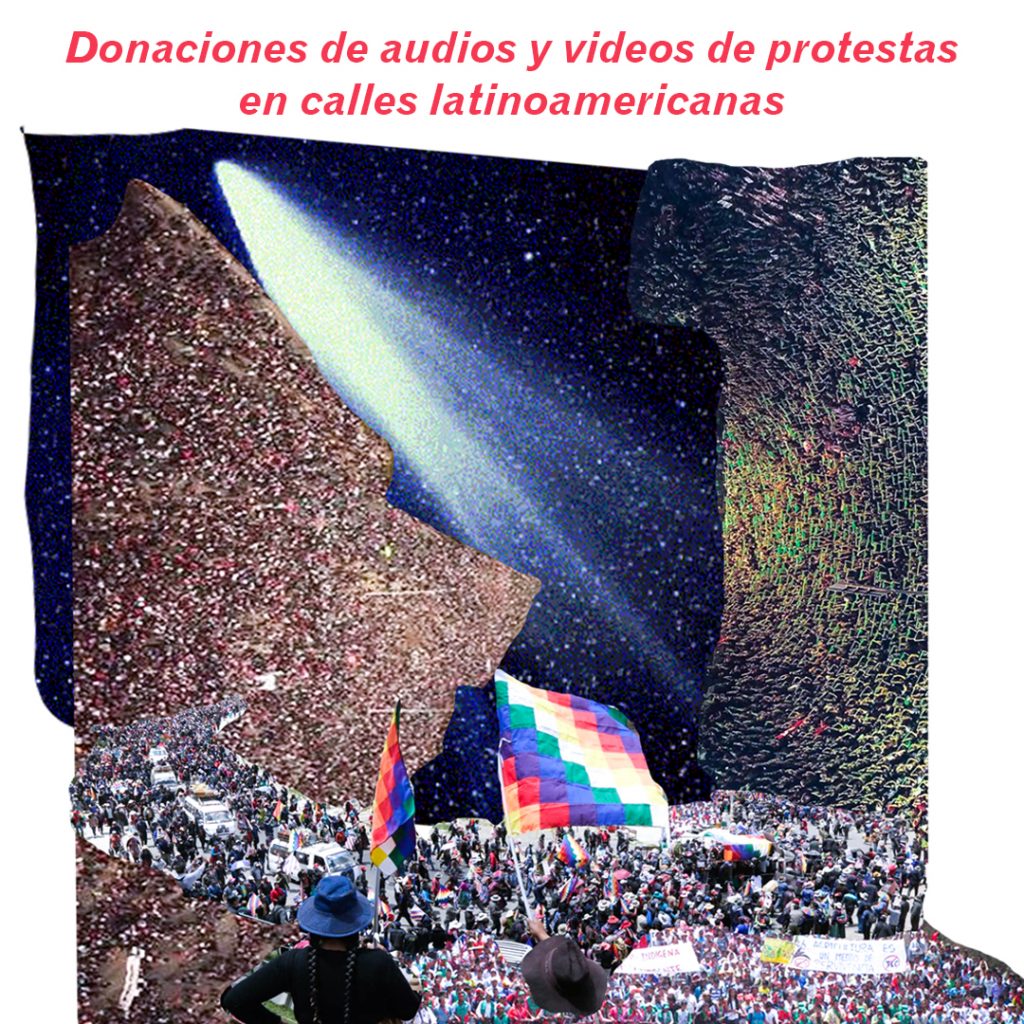
Sound Archive
Concept: Paz Ponce & Manuela García Aldana
Editing: Manuela García Aldana
Content source: anonymous audio donations (Argentina, Brazil, Bolivia, Chile, Colombia, Cuba, Ecuador, Peru)
0:24:27
A sound piece produced in a participatory way with anonymous donations of audio recordings of moments of protests in the public space of different Latin American cities. Conceived by the Office of Dreams as an audio guide, this museological resource consists of material that deals with the sound dimension of the revolts and protests, assembling to the exhibition journey a transnational landscape of “voice uprisings” that travelled like a wave of social indignation across the Latin American continent since autumn 2019, highlighting the system failures of states whose welfare does not represent the citizenship.
* The audio guide is played once a day in the Kiosk Square.
* Use your headphones to listen to the piece through this QR code
0:00:09 · Bogotá, Colombia · 2019 · 21N
0:01:03 · La Habana, Cuba · 2020 · Manifestación frente al Ministerio de Cultura en solidaridad con el movimiento San Isidro / Demonstration in front of the Ministry of Culture in solidarity with San Isidro movement
0:01:25 · La Unión, Chile · 2019 · Protesta feminista / Feminist protest
0:01:36 · Bogotá, Colombia · 2019 · 21N
0:02:51 · Bogotá, Colombia · 2020 · Paro Nacional, Minga Indígena / National strike, Indigenous Minga
0:03:27 · Lima, Perú · 2020
0:04:20 · Bogotá, Colombia · 2019 · Minga indígena apoya el paro nacional / Indigenous Minga supports the national strike
0:04:55 · Porto Alegre, Brasil · 2020 · Fora Bolsonaro
0:05:44 · Bogotá, Colombia · 2019 · 21N
0:05:48 · Bogotá, Colombia · 2020 · Apoyo a los campesinos / Support for farmers
0:06:22 · La Habana, Cuba · 2020 · Manifestación frente al Ministerio de Cultura en solidaridad con el movimiento San Isidro. / Demonstration in front of the Ministry of Culture in solidarity with San Isidro movement
0:06:55 · La Unión, Chile · 2019 · Protesta feminista / Feminist protest
0:07:16 · Porto Alegre, Brasil · 2020 · Fora Bolsonaro
0:07:29 · Bogotá, Colombia · 2020 · Paro Nacional / National strike
0:08:06 · Bogotá, Colombia · 2019 · 21N
0:09:09 · Bogotá, Colombia · 2020 · Apoyo a los campesinos / Support for farmers
0:09:23 · La Unión, Chile · 2019 · Protesta feminista / Feminist protest
0:12:19 · Bogotá, Colombia · 2019 · 21N
0:12:30 · La Unión, Chile · 2019 · Protesta feminista / Feminist protest
0:12:34 · Bogotá, Colombia · 2019 · 21N
0:12:40 · La Habana, Cuba · 2020 · Manifestación frente al Ministerio de Cultura en solidaridad con el movimiento San Isidro. / Demonstration in front of the Ministry of Culture in solidarity with San Isidro movement
0:14:23 · Cuba · 2020 · Revolución de los aplausos, Movimiento San Isidro, Movimiento 27N. / Applause Revolution, San Isidro Movement, 27N Movement.
0:14:43 · La Paz, Bolivia · 2019 · Paro Nacional / National strike
0:15:26 · Quito, Ecuador · 2019 · Paro Nacional / National strike
0:15:36 · Bolivia · 2019 · Paro Nacional / National strike
0:15:41 · Ecuador · 2019 · Paro Nacional / National strike
0:15:53 · Quito, Ecuador · 2019 · Paro Nacional / National strike
0:17:26 · Argentina · 2020 · Aborto legal / Legal abortion
0:17:47 · Belém, Brasil · 2019 · Manifestación contra recortes a la educación. / Demonstration against education cuts.
0:18:04 · Recife, Brasil · 2019 · Protesta contra Jair Bolsonaro / Protest against Jair Bolsonaro
0:19:19 · Quito, Ecuador · 2019 · Paro Nacional / National strike
0:19:45 · Bogotá, Colombia · 2019 · 21N
0:20:10 · Quito, Ecuador · 2019 · Paro Nacional / National strike
0:21:34 · Recife, Brasil · 2019 · Protesta contra Jair Bolsonaro / Protest against Jair Bolsonaro
0:21:55 · Brasil · 2019 · Manifestación contra recortes a la educación. / Demonstration against education cuts.
0:22:35 · Bogotá · 2019 · Minga indígena, 21N / Indigenous Minga, 21N
0:23:32 · Santiago, Chile · 2019
Manuela García Aldana (Bogotá, Colombia, 1990)
Colombian sound artist based in Berlin. In her process-based work (soundscapes, sound sculptures, listening collective practices and radio shows), listening is the principle and arises as a context-driven response to the search for spaces of encounter. She addresses diaspora and identity questions with the will to unlearn and remember other ways of inhabiting our collective life experience.
She graduated in the Universidad de los Andes (Master of Arts) in Bogotá and currently studies a master’s degree at the Berlin Kunsthochschule Weissensee in spatial strategies (Raumstrategien).
Latest works and compositions have been featured at Kunsthaus Dahlem / Brücke-Museum (Transition Exhibition), nGbK neue Gesellschaft für bildende Kunst e.V. (museo de la democracia), Errant Sound (The Listening Biennial), Real Jardín Botánico de Madrid (Pilar Millán, Simetría de los encuentros) Savvy Contemporary (Invocations For The Phoenix To Find Its Form In Us On Restitution, Rehabilitation and Reparation).
She recently joined SAVVY Contemporary as a curatorial assistant focusing on the sonic.
She has a monthly show at Radio Alhara (Palestine).
https://amuletomanuela.com